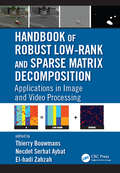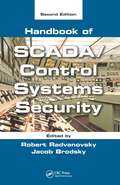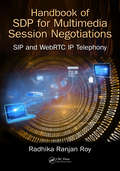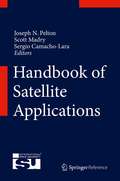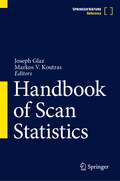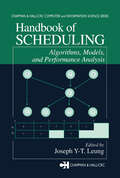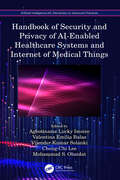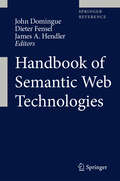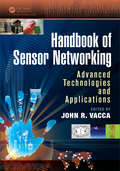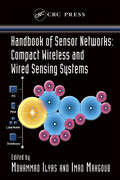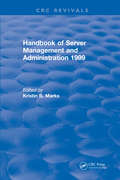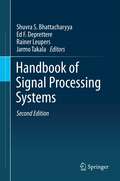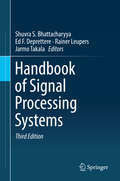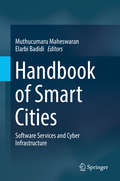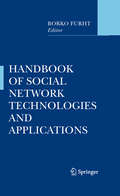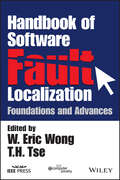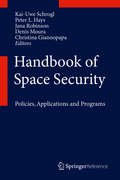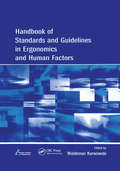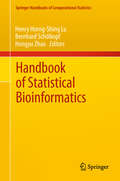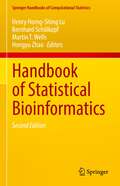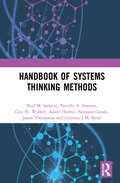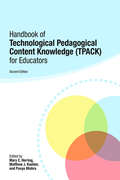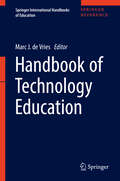- Table View
- List View
Handbook of Robust Low-Rank and Sparse Matrix Decomposition: Applications in Image and Video Processing
by Thierry Bouwmans, Necdet Serhat Aybat and El-hadi ZahzahHandbook of Robust Low-Rank and Sparse Matrix Decomposition: Applications in Image and Video Processing shows you how robust subspace learning and tracking by decomposition into low-rank and sparse matrices provide a suitable framework for computer vision applications. Incorporating both existing and new ideas, the book conveniently gives you one-stop access to a number of different decompositions, algorithms, implementations, and benchmarking techniques. Divided into five parts, the book begins with an overall introduction to robust principal component analysis (PCA) via decomposition into low-rank and sparse matrices. The second part addresses robust matrix factorization/completion problems while the third part focuses on robust online subspace estimation, learning, and tracking. Covering applications in image and video processing, the fourth part discusses image analysis, image denoising, motion saliency detection, video coding, key frame extraction, and hyperspectral video processing. The final part presents resources and applications in background/foreground separation for video surveillance. With contributions from leading teams around the world, this handbook provides a complete overview of the concepts, theories, algorithms, and applications related to robust low-rank and sparse matrix decompositions. It is designed for researchers, developers, and graduate students in computer vision, image and video processing, real-time architecture, machine learning, and data mining.
Handbook of SCADA/Control Systems Security
by Burt G. LookThis comprehensive handbook covers fundamental security concepts, methodologies, and relevant information pertaining to supervisory control and data acquisition (SCADA) and other industrial control systems used in utility and industrial facilities worldwide. Including six new chapters, six revised chapters, and numerous additional figures, photos, and illustrations, it addresses topics in social implications and impacts, governance and management, architecture and modeling, and commissioning and operations. It presents best practices as well as methods for securing a business environment at the strategic, tactical, and operational levels.
Handbook of SDP for Multimedia Session Negotiations: SIP and WebRTC IP Telephony
by Radhika Ranjan RoyThis book on SDP is the first of this kind that attempts to put all SDP related RFCs together with their mandatory and optional texts in a chronological systematic way as if people can use a single “super-SDP RFC” with almost one-to-one integrity from beginning to end to see the big picture of SDP in addition to base SDP functionalities.
Handbook of Satellite Applications
by Sergio Camacho-Lara Scott Madry Joseph N. PeltonTop space experts from around the world have collaborated to produce this comprehensive, authoritative, and clearly illustrated reference guide to the fast growing, multi-billion dollar field of satellite applications and space communications. This handbook, done under the auspices of the International Space University based in France, addresses not only system technologies but also examines market dynamics, technical standards and regulatory constraints. The handbook is a completely multi-disciplinary reference book that covers, in an in-depth fashion, the fields of satellite telecommunications, Earth observation, remote sensing, satellite navigation, geographical information systems, and geosynchronous meteorological systems. It covers current practices and designs as well as advanced concepts and future systems. It provides a comparative analysis of the common technologies and design elements for satellite application bus structures, thermal controls, power systems, stabilization techniques, telemetry, command and control (TTC), and orbital configurations. These common aspects are addressed in an integrated fashion to explain how all these space systems share similar design features, but also have quite specialized application packages to carry out their various missions. No other reference in print today provides such a comprehensive and in-depth guide to all forms of application satellites, including small sats as used by countries just beginning space application programs.
Handbook of Scan Statistics
by Joseph Glaz Markos V. KoutrasScan statistics, one of the most active research areas in applied probability and statistics, has seen a tremendous growth during the last 25 years. Google Scholar lists about 3,500 hits to references of articles on scan statistics since the year 2020, resulting in over 850 hits to articles per year. This is mainly due to extensive and diverse areas of science and technology where scan statistics have been employed, including: atmospheric and climate sciences, business, computer science, criminology, ecology, epidemiology, finance, genetics and genomics, geographic sciences, medical and health sciences, nutrition, pharmaceutical sciences, physics, quality control and reliability, social networks and veterinary science. This volume of the Handbook of Scan Statistics is a collection of forty chapters, authored by leading experts in the field, outlines the research and the breadthof applications of scan statistics to the numerous areas of science and technology listed above. These chapters present an overview of the theory, methods and computational techniques, related to research in the area of scan statistics and outline future developments. It contains extensive references to research articles, books and relevant computer software. Handbook of Scan Statistics is an excellent reference for researchers and graduate students in applied probability and statistics, as well as for scientists in research areas where scan statistics are used. This volume may also be used as a textbook for a graduate level course on scan statistics.
Handbook of Scheduling: Algorithms, Models, and Performance Analysis (Chapman & Hall/CRC Computer and Information Science Series)
by Joseph Y-T. LeungThis handbook provides full coverage of the most recent and advanced topics in scheduling, assembling researchers from all relevant disciplines to facilitate new insights. Presented in six parts, these experts provides introductory material, complete with tutorials and algorithms, then examine classical scheduling problems. Part 3 explores scheduling models that originate in areas such as computer science, operations research. The following section examines scheduling problems that arise in real-time systems. Part 5 discusses stochastic scheduling and queueing networks, and the final section discusses a range of applications in a variety of areas, from airlines to hospitals.
Handbook of Security and Privacy of AI-Enabled Healthcare Systems and Internet of Medical Things (ISSN)
by Mohammad S. Obaidat Valentina Emilia Balas Vijender Kumar Solanki Agbotiname Lucky Imoize Cheng-Chi LeeThe fast-growing number of patients suffering from various ailments has overstretched the carrying capacity of traditional healthcare systems. This handbook addresses the increased need to tackle security issues and preserve patients’ privacy concerns in Artificial Intelligence of Medical Things (AIoMT) devices and systems.Handbook of Security and Privacy of AI-Enabled Healthcare Systems and the Internet of Medical Things provides new insights into the deployment, application, management, and benefits of AIoMT by examining real-world scenarios. The handbook takes a critical look at existing security designs and offers solutions to revamp traditional security architecture, including the new design of effi cient intrusion detection algorithms, attack prevention techniques, and both cryptographic and noncryptographic solutions. The handbook goes on to discuss the critical security and privacy issues that affect all parties in the healthcare ecosystem and provides practical AI-based solutions.This handbook offers new and valuable information that will be highly beneficial to educators, researchers, and others.
Handbook of Semantic Web Technologies
by Dieter Fensel James A. Hendler John DomingueAfter years of mostly theoretical research, Semantic Web Technologies are now reaching out into application areas like bioinformatics, eCommerce, eGovernment, or Social Webs. Applications like genomic ontologies, semantic web services, automated catalogue alignment, ontology matching, or blogs and social networks are constantly increasing, often driven or at least backed up by companies like Google, Amazon, YouTube, Facebook, LinkedIn and others. The need to leverage the potential of combining information in a meaningful way in order to be able to benefit from the Web will create further demand for and interest in Semantic Web research. This movement, based on the growing maturity of related research results, necessitates a reliable reference source from which beginners to the field can draw a first basic knowledge of the main underlying technologies as well as state-of-the-art application areas. This handbook, put together by three leading authorities in the field, and supported by an advisory board of highly reputed researchers, fulfils exactly this need. It is the first dedicated reference work in this field, collecting contributions about both the technical foundations of the Semantic Web as well as their main usage in other scientific fields like life sciences, engineering, business, or education.
Handbook of Sensor Networking: Advanced Technologies and Applications
by John R. VaccaThis handbook provides a complete professional reference and practitioner's guide to today's advanced sensor networking technologies. It focuses on both established and recent sensor networking theory, technology, and practice. Specialists at the forefront of the field address immediate and long-term challenges and explore practical solutions to a wide range of sensor networking issues. The book covers the hardware of sensor networks, wireless communication protocols, sensor networks software and architectures, wireless information networks, data manipulation, signal processing, localization, and object tracking through sensor networks.
Handbook of Sensor Networks: Compact Wireless and Wired Sensing Systems
by Imad Mahgoub Mohammad IlyrasAs the field of communications networks continues to evolve, the challenging area of wireless sensor networks is rapidly coming of age. Recent advances have made it possible to make sensor components more compact, robust, and energy efficient than ever, earning the idiosyncratic alias ofSmart Dust. Production has also improved, yielding larger,
Handbook of Server Management and Administration: 1999
by Kristin B. MarksServers are the heart of the network. The Handbook of Server Management and Administration keeps you up-to-date with the very latest server technology and gives you the tools you need to choose, configure and maintain a server that will serve users, data streams and corporate goals with equal efficiency. The practical tips and case studies you'll find in the Handbook include detailed explanations of:the case for mainframe servers in the enterpriseserver installation considerationsserver security policiesserver data bus standardsmigrating to NetWare 4.1 and Novell Directory ServicesWindows NT Workstation vs. Server 4.0UNIX as an application serverfax serversInternet e-mail servers the art of placing images and multimedia on the corporate networkand more!The contributing authors to the Handbook of Server Management and Administration are industry experts. Some work at corporations that have designed innovative solutions. Some wear battle scars from the field. Many are experienced writers and public speakers. All of them know what they're talking about. These leading authorities give you a wealth of practical advice, tips and strategies on how to:evaluate anti-virus solutions within distributed environmentsset up fault tolerance protection and RAID technology for networkschoose the best network data and storage management techniques
Handbook of Signal Processing Systems
by Rainer Leupers Ed F. Deprettere Jarmo Takala Shuvra S. BhattacharyyaHandbook of Signal Processing Systems is organized in three parts. The first part motivates representative applications that drive and apply state-of-the art methods for design and implementation of signal processing systems; the second part discusses architectures for implementing these applications; the third part focuses on compilers and simulation tools, describes models of computation and their associated design tools and methodologies. This handbook is an essential tool for professionals in many fields and researchers of all levels.
Handbook of Signal Processing Systems
by Rainer Leupers Ed F. Deprettere Jarmo Takala Shuvra S. BhattacharyyaIn this new edition of the Handbook of Signal Processing Systems, many of the chapters from the previous editions have been updated, and several new chapters have been added. The new contributions include chapters on signal processing methods for light field displays, throughput analysis of dataflow graphs, modeling for reconfigurable signal processing systems, fast Fourier transform architectures, deep neural networks, programmable architectures for histogram of oriented gradients processing, high dynamic range video coding, system-on-chip architectures for data analytics, analysis of finite word-length effects in fixed-point systems, and models of architecture. There are more than 700 tables and illustrations; in this edition over 300 are in color. This new edition of the handbook is organized in three parts. Part I motivates representative applications that drive and apply state-of-the art methods for design and implementation of signal processing systems; Part II discusses architectures for implementing these applications; and Part III focuses on compilers, as well as models of computation and their associated design tools and methodologies.
Handbook of Smart Cities: Software Services and Cyber Infrastructure
by Muthucumaru Maheswaran Elarbi BadidiThis handbook provides a glimpse of the research that is underway in smart cities, with an examination of the relevant issues. It describes software infrastructures for smart cities, the role of 5G and Internet of things in future smart cities scenarios, the use of clouds and sensor-based devices for monitoring and managing smart city facilities, a variety of issues in the emerging field of urban informatics, and various smart city applications. Handbook of Smart Cities includes fifteen chapters from renowned worldwide researchers working on various aspects of smart city scale cyber-physical systems. It is intended for researchers, developers of smart city technologies and advanced-level students in the fields of communication systems, computer science, and data science. This handbook is also designed for anyone wishing to find out more about the on-going research thrusts and deployment experiences in smart cities. It is meant to provide a snapshot of the state-of-the-art at the time of its writing in several software services and cyber infrastructures as pertinent to smart cities. This handbook presents application case studies in video surveillance, smart parking, and smart building management in the smart city context. Unique experiences in designing and implementing the applications or the issues involved in developing smart city level applications are described in these chapters. Integration of machine learning into several smart city application scenarios is also examined in some chapters of this handbook.
Handbook of Social Network Technologies and Applications
by Borko FurhtSocial networking is a concept that has existed for a long time; however, with the explosion of the Internet, social networking has become a tool for people to connect and communicate in ways that were impossible in the past. The recent development of Web 2.0 has provided many new applications, such as Myspace, Facebook, and LinkedIn. The purpose of Handbook of Social Network Technologies and Applications is to provide comprehensive guidelines on the current and future trends in social network technologies and applications in the field of Web-based Social Networks. This handbook includes contributions from world experts in the field of social networks from both academia and private industry. A number of crucial topics are covered including Web and software technologies and communication technologies for social networks. Web-mining techniques, visualization techniques, intelligent social networks, Semantic Web, and many other topics are covered. Standards for social networks, case studies, and a variety of applications are covered as well.
Handbook of Software Fault Localization: Foundations and Advances
by W. Eric Wong T. H. TseHandbook of Software Fault Localization A comprehensive analysis of fault localization techniques and strategies In Handbook of Software Fault Localization: Foundations and Advances, distinguished computer scientists Prof. W. Eric Wong and Prof. T.H. Tse deliver a robust treatment of up-to-date techniques, tools, and essential issues in software fault localization. The authors offer collective discussions of fault localization strategies with an emphasis on the most important features of each approach. The book also explores critical aspects of software fault localization, like multiple bugs, successful and failed test cases, coincidental correctness, faults introduced by missing code, the combination of several fault localization techniques, ties within fault localization rankings, concurrency bugs, spreadsheet fault localization, and theoretical studies on fault localization. Readers will benefit from the authors’ straightforward discussions of how to apply cost-effective techniques to a variety of specific environments common in the real world. They will also enjoy the in-depth explorations of recent research directions on this topic. Handbook of Software Fault Localization also includes: A thorough introduction to the concepts of software testing and debugging, their importance, typical challenges, and the consequences of poor efforts Comprehensive explorations of traditional fault localization techniques, including program logging, assertions, and breakpoints Practical discussions of slicing-based, program spectrum-based, and statistics-based techniques In-depth examinations of machine learning-, data mining-, and model-based techniques for software fault localization Perfect for researchers, professors, and students studying and working in the field, Handbook of Software Fault Localization: Foundations and Advances is also an indispensable resource for software engineers, managers, and software project decision makers responsible for schedule and budget control. </p
Handbook of Space Security
by Kai-Uwe Schrogl Peter L. Hays Jana Robinson Denis Moura Christina GiannopapaSpace Security involves the use of space (in particular communication, navigation, earth observation, and electronic intelligence satellites) for military and security purposes on earth and also the maintenance of space (in particular the earth orbits) as safe and secure areas for conducting peaceful activities. The two aspects can be summarized as "space for security on earth" and the safeguarding of space for peaceful endeavors. The Handbook will provide a sophisticated, cutting-edge resource on the space security policy portfolio and the associated assets, assisting fellow members of the global space community and other interested policy-making and academic audiences in keeping abreast of the current and future directions of this vital dimension of international space policy. The debate on coordinated space security measures, including relevant 'Transparency and Confidence-Building Measures, ' remains at a relatively early stage of development. The book offers a comprehensive description of the various components of space security and how these challenges are being addressed today. It will also provide a number of recommendations concerning how best to advance this space policy area, given the often competing objectives of the world's major space-faring nations. The critical role to be played by the United States and Europe as an intermediary and "middle diplomat" in promoting sustainable norms of behavior for space will likewise be highlighted. In providing a global and coherent analytical approach to space security today, theHandbook focuses on four areas that together define the entire space security area: policies, technologies, applications, and programs. This structure will assure the overall view of the subject from its political to its technical aspects. Internationally recognized experts in each of the above fields contribute, with their analytical synthesis assured by the section editors. "
Handbook of Standards and Guidelines in Ergonomics and Human Factors
by Waldema KarwowskiA comprehensive review of international and national standards and guidelines, this handbook consists of 32 chapters divided into nine sections that cover standardization efforts, anthropometry and working postures, designing manual material, human-computer interaction, occupational health and safety, legal protection, military human factor standar
Handbook of Statistical Bioinformatics
by Bernhard Schölkopf Henry Horng-Shing Lu Hongyu ZhaoNumerous fascinating breakthroughs in biotechnology have generated large volumes and diverse types of high throughput data that demand the development of efficient and appropriate tools in computational statistics integrated with biological knowledge and computational algorithms. This volume collects contributed chapters from leading researchers to survey the many active research topics and promote the visibility of this research area. This volume is intended to provide an introductory and reference book for students and researchers who are interested in the recent developments of computational statistics in computational biology.
Handbook of Statistical Bioinformatics (Springer Handbooks of Computational Statistics)
by Bernhard Schölkopf Henry Horng-Shing Lu Hongyu Zhao Martin T. WellsNow in its second edition, this handbook collects authoritative contributions on modern methods and tools in statistical bioinformatics with a focus on the interface between computational statistics and cutting-edge developments in computational biology. The three parts of the book cover statistical methods for single-cell analysis, network analysis, and systems biology, with contributions by leading experts addressing key topics in probabilistic and statistical modeling and the analysis of massive data sets generated by modern biotechnology. This handbook will serve as a useful reference source for students, researchers and practitioners in statistics, computer science and biological and biomedical research, who are interested in the latest developments in computational statistics as applied to computational biology.
Handbook of Systems Thinking Methods
by Jason Thompson Neville A. Stanton Guy H. Walker Paul M. Salmon Natassia Goode Adam Hulme Gemma J.M. ReadThe systems thinking philosophy has become popular in human factors and ergonomics and safety science. These methods are being used to understand and resolve complex societal problems in areas such as transport safety, workplace safety, medication error, disaster management, child abuse, financial crises, terrorism, climate change and public health and wellbeing. This handbook presents practical step-by-step guidance for practitioners and researchers wishing to use these methods to tackle complex problems. Each method includes an example case study which demonstrates how the method can be applied and how the results can be interpreted and translated into practical recommendations. The book presents practical guidance on state-of-the-art systems thinking methods and offers case study applications describing systems thinking methods in novel areas. It explains how to translate the outputs of systems thinking methods in practice and introduces systems thinking with an overview of Human Factors and Ergonomics applications. This book will serve as a great reference for students and engineers in the field of systems engineering, complex systems and the design and development of systems, including ergonomics/human factors and systems engineers, designers, architects, industrial engineers, project management engineers, reliability engineers, risk engineers, software engineers and computer engineers.
Handbook of Technological Pedagogical Content Knowledge (TPACK) for Educators
by Mary C. Herring, Matthew J. Koehler and Punya MishraThe 2nd edition of the Handbook of Technological Pedagogical Content Knowledge (TPACK) for Educators addresses the concept and implementation of technological pedagogical content knowledge—the knowledge and skills that teachers need in order to integrate technology meaningfully into instruction in specific content areas. Driven by the growing influence of TPACK on research and practice in both K-12 and higher education, the 2nd edition updates current thinking about theory, research, and practice. Offering a series of chapters by scholars in different content areas who apply the technological pedagogical content knowledge framework to their individual content areas, the volume is structured around three themes: Current thoughts on TPACK Theory Research on Technological Pedagogical Content Knowledge in Specific Subject Areas Integrating Technological Pedagogical Content Knowledge into Teacher Education and Professional Development The Handbook of Technological Pedagogical Content Knowledge (TPACK) for Educators is simultaneously a mandate and a manifesto on the engagement of technology in classrooms.
Handbook of Technology Education
by Marc J. de VriesThis handbook of technology education offers a state-of-the-art survey of developments in technology education worldwide. It deals with general themes like philosophical foundations, curriculum, teaching and learning, teacher education, and educational technology. It also has some technology-specific topics, such as designing, making, and assessment (portfolios). To focus on the specific learning challenges a separate section of the book is dedicated to sub-domains of technology and engineering, like food, textiles, materials and robotics. Explicit attention is given to the possible role of technology (and engineering) education in Science, Technology, Engineering and Mathematics (STEM) education. Recent developments such as technology concept learning, authentic learning, pre-university engineering education, design-based learning and design-based research for technology education, pedagogical content knowledge for technology educators, and the use of e-portfoli os are included. One section deals with social and cultural issues, such as education for sustainability, gender issues in technology education, indigenous technologies, industry involvement and the relation between technology education and communication. As could be expected in a handbook on technology education, there is also a section on the use of technology for teaching about technology: the use of CAD, science fiction movies, animations, internet and social media. All chapters are written especially for this handbook by a selection of authors, some of whom have been part of the history of technology education for many years, some of whom are promising young researchers. The book can be used as a reference by technology education researchers to get a concise introduction into the field. It can also be used as a resource in technology teacher education programs. Technology teachers can use it as literature for deepening their understanding of the field and thus working on their continuous professionalization. Curriculum developers and policy makers will find it of interest to get an understanding for the need to have technology education in the curriculum and the way it can be realized in practice.
Handbook of Technology in Financial Services
by Jessica KeyesThe calculus of IT support for the banking, securities and insurance industries has changed dramatically and rapidly over the past few years. Unheard of just a few years ago, corporate intranets are now used for everything from job postings to enhanced team communications. Whole new departments are being created to support e-commerce. And the Internet/Intranet/Extranet triple-whammy is the most critical component of most financial IT shops. At the same time, intelligent agents stand ready to take on such diverse functions as customer profiling and data mining.
Handbook of Terrorist and Insurgent Groups: A Global Survey of Threats, Tactics, and Characteristics
by Animesh Roul Scott N. Romaniuk János Besenyő Amparo Pamela FabeHandbook of Terrorist and Insurgent Groups: A Global Survey of Threats, Tactics, and Characteristics examines the most current and significant terrorist and insurgent groups around the world. The purpose is to create a descriptive mosaic of what is a pointedly global security challenge.The volume brings together conceptual approaches to terrorism, insurgency, and cyberterrorism with substantive and empirical analyses of individual groups, organisations, and networks. By doing so, not only does the coverage highlight the past, present, and future orientations of the most prominent groups, but it also examines and illustrates their key characteristics and how they operate, including key leaders and ideologues. Highlighting specific, individual groups, the chapters collectively present a robust and comprehensive outlook on the current geography of terrorism and insurgency groups operating in the world today.This comprehensive volume brings the collective expertise and knowledge of more than 50 academics, intelligence and security officials, and professionals together, all of whom are considered subject experts in their respective areas of research and practice. The volume is based on both desk-based and fieldwork conducted by experts in these areas, incorporating analyses of secondary literature but also the use of primary data including first-hand interviews on the various groups’ regions of operation, their tactics, and how their ideologies motivate their actions.
